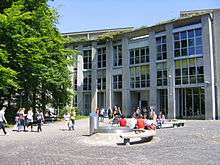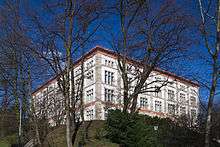Kantonsschule Rämibühl
The Kantonsschule Rämibühl at the Rämistrasse in Zurich, founded in 1832 as "Kantonsschule Zürich" consists of four Kantonsschulen (Sekundarstufe I&II) with different curricular profiles. The four schools, which are attended by more than 2000 students in total, are the Literargymnasium, the Realgymnasium, the Mathematisch-Naturwissenschaftliches Gymnasium and the Kunst- und Sportgymnasium Rämibühl.
| Kantonsschule Rämibühl | |
|---|---|
| Address | |
Rämistrasse 56/58, 8001 Zürich Zurich | |
| Information | |
| Type | Public coeducational |
| Established | 1832 |
| Grades | Langzeit- and Kurzzeitmittelschule (7-12, 9-12) |
| Enrollment | >2000 |
| Campus | Urban |
| composed of | Literargymnasium (Langgymnasium) Realgymnasium (Lang-) Mathematisch-Naturwissenschaftliches Gymnasium (Kurz-) Kunst -& Sport-Gymnasium (Kurz-) |
| Website | http://www.rgzh.ch http://www.lgr.ch http://www.mng.ch http://www.ksgymnasium.ch |
 Current school building | |



The Literargymnasium and the Realgymnasium, which focus on languages and humanities, were the first Swiss state-run schools to offer the International Baccalaureate Diploma Programme. Thus, in grades 9-12, some classes are taught in English (the primary language of the school being German). The Literaturgymnasium also offers extensive courses in Classics including Latin and classical Greek.[1]
The Mathematisch-Naturwissenschaftliches Gymnasium Rämibühl (MNG) is particularly strong in mathematics and science. The usual duration of attendance is 4 years. After 2 years, students decide to focus either on Biology & Chemistry or Physics & Applied Mathematics as core subjects.
The current school headmaster is Rektor Dr. Daniel Reichmuth. The vice-headmasters (Prorektor) are Susanne Kalt and Samuel Byland.
The Kunst- und Sportgymnasium is attended by students which have a particular talent in arts or sports. It is located in the same building as the MNG.
All the schools support music and thus there exists not only a well-known orchestra but also various school bands as well as a Department for individual musical education.
External links
- Literargymnasium
- Realgymnasium
- Mathematisch-Naturwissenschaftliches Gymnasium
- Kunst und Sportgymasium